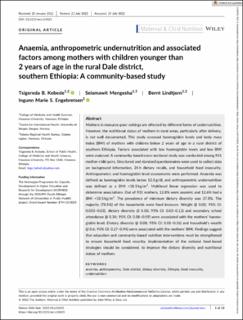| dc.contributor.author | Kebede, Tsigereda Behailu | |
| dc.contributor.author | Mengesha, Selamawit | |
| dc.contributor.author | Lindtjorn, Bernt | |
| dc.contributor.author | Engebretsen, Ingunn Marie Stadskleiv | |
| dc.date.accessioned | 2022-11-18T10:07:11Z | |
| dc.date.available | 2022-11-18T10:07:11Z | |
| dc.date.created | 2022-11-07T12:25:52Z | |
| dc.date.issued | 2022 | |
| dc.identifier.issn | 1740-8695 | |
| dc.identifier.uri | https://hdl.handle.net/11250/3032809 | |
| dc.description.abstract | Mothers in resource-poor settings are affected by different forms of undernutrition. However, the nutritional status of mothers in rural areas, particularly after delivery, is not well documented. This study assessed haemoglobin levels and body mass index (BMI) of mothers with children below 2 years of age in a rural district of southern Ethiopia. Factors associated with low haemoglobin levels and low BMI were analysed. A community-based cross-sectional study was conducted among 931 mother-child pairs. Structured and standard questionnaires were used to collect data on background information, 24 h dietary recalls, and household food insecurity. Anthropometric and haemoglobin level assessments were performed. Anaemia was defined as haemoglobin levels below 12.0 g/dl, and anthropometric undernutrition was defined as a BMI <18.5 kg/m2. Multilevel linear regression was used to determine associations. Out of 931 mothers, 12.8% were anaemic and 12.6% had a BMI <18.5 kg/m2. The prevalence of minimum dietary diversity was 37.8%. The majority (78.5%) of the households were food insecure. Weight (β 0.02; 95% CI: 0.003−0.03), dietary diversity (β 0.08; 95% CI: 0.03−0.12) and secondary school attendance (β 0.34; 95% CI: 0.08−0.59) were associated with the mothers' haemoglobin level. Dietary diversity (β 0.08; 95% CI: 0.01−0.16) and household's wealth (β 0.6; 95% CI: 0.27−0.94) were associated with the mothers' BMI. Findings suggest that education and community-based nutrition interventions must be strengthened to ensure household food security. Implementation of the national food-based strategies should be considered, to improve the dietary diversity and nutritional status of mothers. | en_US |
| dc.language.iso | eng | en_US |
| dc.publisher | Wiley | en_US |
| dc.rights | Attribution-NonCommercial-NoDerivatives 4.0 Internasjonal | * |
| dc.rights.uri | http://creativecommons.org/licenses/by-nc-nd/4.0/deed.no | * |
| dc.title | Anaemia, anthropometric undernutrition and associated factors among mothers with children younger than 2 years of age in the rural Dale district, southern Ethiopia: A community-based study | en_US |
| dc.type | Journal article | en_US |
| dc.type | Peer reviewed | en_US |
| dc.description.version | publishedVersion | en_US |
| dc.rights.holder | Copyright 2022 The Author(s) | en_US |
| dc.source.articlenumber | e13423 | en_US |
| cristin.ispublished | true | |
| cristin.fulltext | original | |
| cristin.qualitycode | 1 | |
| dc.identifier.doi | 10.1111/mcn.13423 | |
| dc.identifier.cristin | 2069917 | |
| dc.source.journal | Maternal & Child Nutrition | en_US |
| dc.identifier.citation | Maternal & Child Nutrition. 2022, 18 (4), e13423. | en_US |
| dc.source.volume | 18 | en_US |
| dc.source.issue | 4 | en_US |

